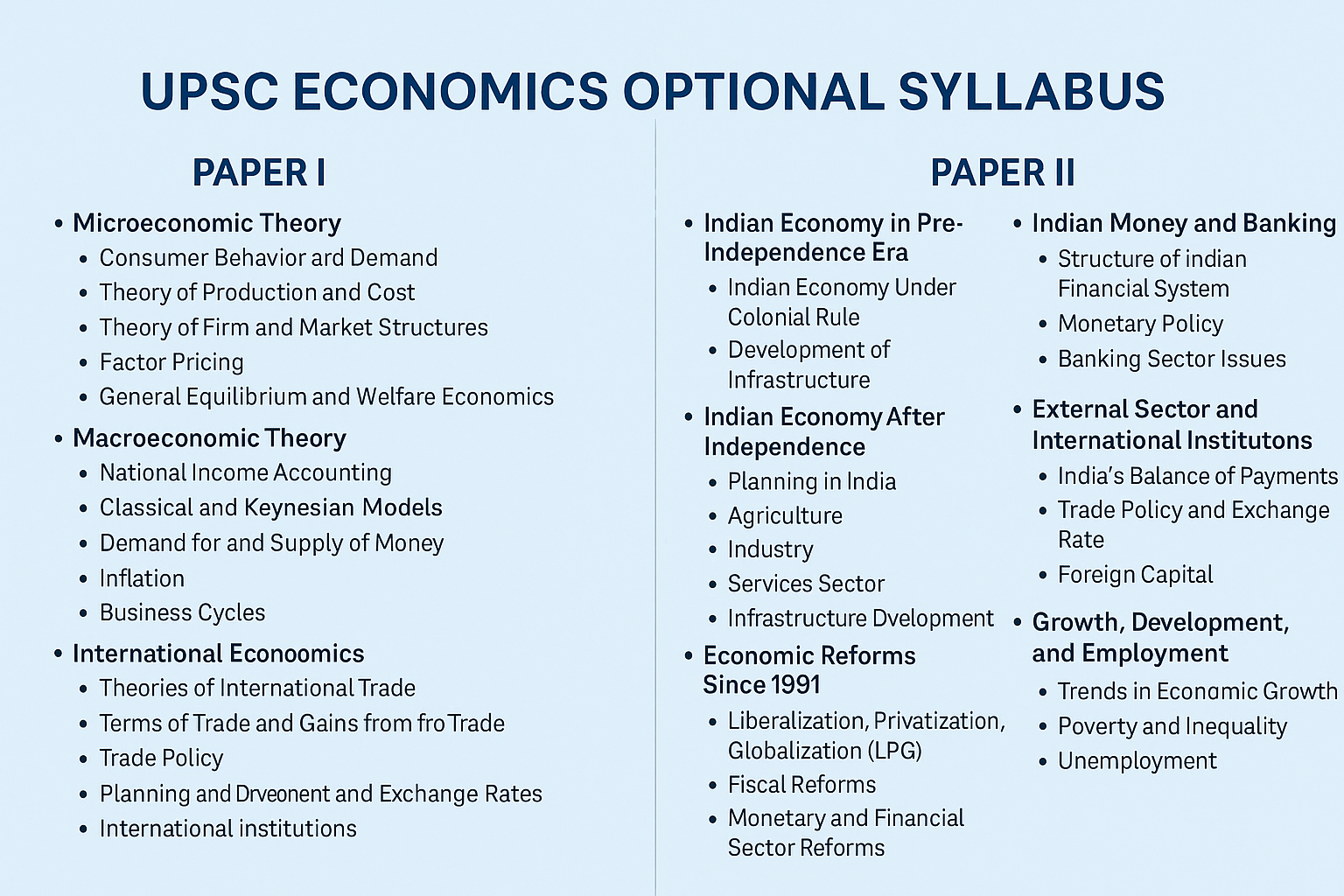UPSC Economics Optional Syllabus 2025 – Detailed Paper I & II Topics
Economics Optional – Paper I
1. Microeconomic Theory
- Consumer Behavior and Demand
- Cardinal and ordinal utility analysis
- Indifference curve approach
- Income and substitution effects (Hicks and Slutsky)
- Revealed preference theory
- Consumer surplus
- Elasticity of demand – price, income, cross
- Theory of Production and Cost
- Production functions (short-run and long-run)
- Law of variable proportions
- Isoquants and returns to scale
- Cost curves – traditional and modern
- Theory of Firm and Market Structures
- Perfect competition – short-run and long-run equilibrium
- Monopoly – price discrimination, regulation
- Monopolistic competition – Chamberlin model
- Oligopoly – Cournot, Bertrand, Edgeworth models; kinked demand curve
- Pricing strategies and contestable markets
Join WhatsApp community for Free Notifications, Updates, Study Material, Mock Tests, Internship Updates, and Current Affairs - CLICK HERE TO JOIN
- Factor Pricing
- Marginal productivity theory
- Theories of rent – Ricardian, modern
- Theories of wage – marginal productivity, modern
- Interest and profit – classical, Keynesian, Schumpeterian theories
- General Equilibrium and Welfare Economics
- Partial and general equilibrium
- Pareto optimality, social welfare function
- Compensation criteria – Kaldor-Hicks
- Arrow’s impossibility theorem, Rawlsian concept of justice
2. Macroeconomic Theory
- National Income Accounting
- Concepts – GDP, GNP, NDP, NNP
- Measurement – product, income, and expenditure approaches
- Green accounting and limitations of GDP as an indicator
- Classical and Keynesian Models
- Say’s Law, classical dichotomy, neutrality of money
- Keynesian revolution – effective demand, consumption function
- Investment multiplier and accelerator
- IS-LM model – equilibrium in goods and money markets
- Demand for and Supply of Money
- Quantity theory of money – Fisher and Cambridge versions
- Keynesian liquidity preference theory
- Monetarist approach – Friedman’s theory
- Inflation
- Causes and consequences – demand-pull and cost-push
- Phillips curve – short-run and long-run
- Stagflation and supply-side economics
- Business Cycles
- Theories – Schumpeter, Kaldor, Samuelson, Hicks
- Real business cycle theory
- Monetary and Fiscal Policies
- Objectives and instruments
- Effectiveness in IS-LM framework
- Crowding out, Ricardian equivalence
- Monetary policy transmission mechanisms
- Central bank independence
To Enroll in FIRST IAS INSTITUTE - Click Here
3. International Economics
- Theories of International Trade
- Classical – absolute and comparative advantage (Ricardo)
- Heckscher-Ohlin model
- New trade theories – intra-industry trade, increasing returns
- Terms of Trade and Gains from Trade
- Concept of terms of trade – net barter, gross barter, income terms
- Static and dynamic gains from trade
- Trade Policy
- Tariffs and quotas – economic effects
- Non-tariff barriers
- Trade liberalization and protectionism
- Balance of Payments and Exchange Rates
- Components of BOP, disequilibrium, and adjustment mechanisms
- Exchange rate determination – fixed vs flexible regimes
- Purchasing Power Parity (PPP), Interest Rate Parity
- Devaluation and depreciation
- International Institutions
- IMF, World Bank, WTO – objectives and functions
- SDRs and international liquidity
- Current issues in global trade and finance
4. Growth and Development
- Concepts and Measurement
- Economic growth vs economic development
- Human development index (HDI), gender development index (GDI)
- Inequality and poverty indices – Lorenz curve, Gini coefficient
- Theories of Development
- Classical – Smith, Ricardo, Marx
- Neo-classical – Solow model
- Harrod-Domar model, endogenous growth models (Romer, Lucas)
- Development Strategies
- Balanced and unbalanced growth
- Big Push, Critical Minimum Effort thesis
- Dual economy models – Lewis, Fei-Ranis
- Planning and Development
- Planning techniques – Input-output analysis, project appraisal
- Role of state and market in development
- Sustainable development – green economy, inclusive growth
- Trade and Development
- Prebisch-Singer thesis
- Export-led growth
- Capital flows – FDI, portfolio investment, remittances
- Finance and Development
- Role of financial institutions in development
- Microfinance, financial inclusion
- Shadow banking and fintech in development
Join WhatsApp community for Free Notifications, Updates, Study Material, Mock Tests, Internship Updates, and Current Affairs - CLICK HERE TO JOIN
Economics Optional – Paper II
1. Indian Economy in Pre-Independence Era
- Indian Economy Under Colonial Rule
- Structure and characteristics
- Impact of British policies on agriculture, industry, trade
- Deindustrialization debate
- Drain of wealth theory – Dadabhai Naoroji, R.C. Dutt
- Development of Infrastructure
- Railways and communication
- Irrigation and public works
- Education and health services under British rule
2. Indian Economy After Independence
- Planning in India
- Objectives and achievements of Five-Year Plans
- Planning Commission and NITI Aayog – structure and functions
- Failures and limitations of planning
- Agriculture
- Land reforms – abolition of zamindari, tenancy reforms
- Green Revolution – impacts and limitations
- Agricultural subsidies and MSP
- WTO and Indian agriculture
- Industry
- Industrial policy resolutions – 1948, 1956, 1991
- Role of PSUs and privatization
- MSMEs – challenges and policies
- Services Sector
- Growth and contribution to GDP and employment
- IT and telecom revolution
- Financial and real estate services
- Infrastructure Development
- Physical and social infrastructure
- Public-private partnerships (PPP)
- Smart cities and urban infrastructure
3. Economic Reforms Since 1991
- Liberalization, Privatization, Globalization (LPG)
- Background and objectives of 1991 reforms
- Impact on agriculture, industry, and services
- Second-generation reforms
- Fiscal Reforms
- Tax reforms – GST, FRBM Act
- Expenditure rationalization
- Monetary and Financial Sector Reforms
- Role of RBI, monetary policy framework
- Financial inclusion and banking reforms – NPA, IBC, recapitalization
- External Sector Reforms
- Exchange rate management – convertibility of rupee
- FDI and foreign exchange reserves
- Current account deficit and capital account management
- Social Sector and Welfare Schemes
- Education and health indicators
- Poverty alleviation and employment schemes – MNREGA, PMAY
- Direct benefit transfers and JAM trinity
To Enroll in FIRST IAS INSTITUTE - Click Here
4. Indian Public Finance
- Taxation and Expenditure
- Trends in revenue and expenditure
- Tax reforms and fiscal federalism
- Direct and indirect taxes – GST framework
- Budgeting Process
- Types of budget – revenue, capital, zero-based
- Role of Finance Commission and Fiscal Council
- Deficits and Debt
- Fiscal deficit, primary deficit, revenue deficit
- Public debt management – internal and external
- Contingent liabilities and off-budget borrowing
5. Indian Money and Banking
- Structure of Indian Financial System
- Commercial banks, cooperative banks, NBFCs
- Role and regulation by RBI
- Monetary Policy
- Instruments – CRR, SLR, repo, reverse repo
- Inflation targeting – MPC framework
- Financial market development – call money, treasury bills
- Banking Sector Issues
- Non-performing assets (NPAs)
- Consolidation of banks, digital banking
- Financial inclusion – PM Jan Dhan Yojana, fintech innovations
Join WhatsApp community for Free Notifications, Updates, Study Material, Mock Tests, Internship Updates, and Current Affairs - CLICK HERE TO JOIN
6. External Sector and International Institutions
- India’s Balance of Payments
- Trade balance and current account
- Capital account convertibility
- Trends in exports, imports, remittances
- Trade Policy and Exchange Rate
- WTO and India’s trade relations
- Export promotion measures – SEZs, export subsidies
- Exchange rate regimes – managed float, intervention policy
- Foreign Capital
- FDI and FII – trends and policies
- Bilateral investment treaties
- External commercial borrowings
7. Growth, Development, and Employment
- Trends in Economic Growth
- Sectoral composition – agriculture, industry, services
- Inclusive and sustainable development
- Poverty and Inequality
- Measurement and trends – NSSO, NFHS data
- Policy responses – food security, direct transfers
- Unemployment
- Types and measurement of unemployment in India
- Informal sector and labor reforms
- Demographic dividend and skill development
Would you like a PDF version of this syllabus or a study plan based on this?


 firstiasofficial@gmail.com
firstiasofficial@gmail.com
Leave a Comment